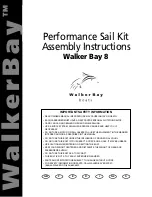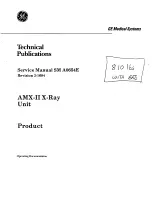
5/18
PWR LED
LEDs P1,
P2
Possible fault cause
Green
Red x 1
Blue x 1
Restorable fault: overcurrent on Tx or Ox outputs.
Recommended action: disconnect the semiconductor signalling outputs
(Ox) and the test outputs (Tx) to check whether an external short circuit
is present.
Green
Red x 1
Blue x 2
Restorable fault: problem detected on OSx (short circuit towards earth or
positive pole, or else short circuit between two OSx).
Suggested action: Disconnect the safety outputs to check if there are any
problems on the external connections of the OSx outputs.
Green
Red x 1
Blue x 3
Restorable fault: module temperature outside the limits.
Suggested action: restore module temperature to within permissible limits.
Green
Red x 1
Blue x 4
Restorable fault: No power on 24V-0V terminals.
Recommended action: Check electrical connections
Green
Blue x N
Module entered ERROR state at the request of the application program.
Error code N. Typically due to incorrect input conditions (external short
circuits, status not permitted).
Suggested action: disconnect the inputs to find any short circuits. Check
the documentation supplied with the application program for further
details.
7 INSTRUCTIONS FOR PROPER USE
7.1 Installation
Attention: Do not exceed the tightening torque of the terminal screws specified
in the present operating instructions.
Attention: Observe the wiring of the terminals: incorrect wiring can damage the
device which may result in loss of the safety function.
Attention: This is a complex device, designed to provide safety functions to
protect machine operators. The hardware and software of this device, external devices,
general circuit design and building, are all essential if specific safety goals are to
be reached. Therefore, only qualified operators with suitable knowledge of electrical
systems and safety regulations should install this device and put it into service.
- Install only inside a cabinet with protection degree not less than IP54 according to
EN 60529.
- Always affix the device with the specific DIN rail adaptor acc. to EN 60715.
- Do not stress the device with bending or torsion.
- Do not modify or open the device for any reason.
- The device carries out an operator protection function. Any inadequate installation
or tampering can cause serious injuries and even death, property damage, and eco-
nomic losses.
- These devices must not be bypassed, removed or disabled in any other way.
- If the machine where the device is installed is used for a purpose other than that
specified, the device may not provide the operator with efficient protection.
- The safety category of the system (according to EN ISO 13849-1), including the sa-
fety device, also depends on the external components connected to it and their type.
- Before installation, make sure the device is not damaged in any part.
- Before commissioning, check the correct functioning of the module.
- Avoid excessive bending of connection cables in order to prevent any short circuits
or power failures.
- Do not paint or varnish the device.
- Do not drill the device.
- Do not use the device as a support or rest for other structures, such as raceways,
sliding guides or similar.
- Before commissioning, make sure that the entire machine (or system) complies with
all applicable standards and EMC directive requirements.
- The documentation required for correct installation and maintenance is available
online in various languages on the Pizzato Elettrica website.
- This device can only be installed and used if all these technical instructions and all
safety regulations relevant for the application have been observed and implemented.
- Should the installer be unable to fully understand the documents, the product must
not be installed and the necessary assistance may be requested from the manufactu-
rer (see paragraph SUPPORT).
- Always attach the following instructions to the manual of the machine in which the
device is installed.
- These operating instructions must be kept available for consultation at any time and
for the whole period of use of the device.
7.2 Do not use in the following environments
- In environments where continual changes in temperature cause the formation of
condensation inside the device.
- In environments where the application causes the device to be subjected to strong
impacts or vibrations.
- In environments with the presence of explosive or flammable gases or dusts.
- In environments containing strongly aggressive chemicals, where the products used
coming into contact with the device may impair its physical or functional integrity.
- Prior to installation, the installer must ensure that the device is suitable for use under
the ambient conditions on site.
7.3 Maintenance and functional tests
Attention: Do not disassemble or try to repair the device. In case of any malfun-
ction or failure, replace the entire device.
- The device installer is responsible for establishing the sequence of functional tests
to which the device is to be subjected before the machine is started up and during
maintenance intervals.
- The sequence of the functional tests can vary depending on the machine complexity
and circuit diagram, therefore the functional test sequence detailed below is to be
considered as minimal and not exhaustive.
- Perform the following sequence of checks before the machine is commissioned and
at least once a year (or after a prolonged shutdown):
1) Check that the safety module housing is undamaged and in good condition. If the
housing is damaged, replace the entire device.
2) Check that all signalling LEDs are working.
3) Check that the electrical cables are firmly lodged inside the terminals and connectors.
4) Check that the module functions as required by the application program.
- The device has been created for applications in dangerous environments, therefore it
has a limited service life. Although still functioning, after 20 years from the date of ma-
nufacture the device must be replaced completely. The date of manufacture is placed
next to the product code (see paragraph MARKINGS).
7.4 Wiring
Attention: Do not install the safety module if voltage is present. Power the device
only when the electrical circuits have been completely realized according to the speci-
fications indicated in the OPERATION paragraph. The first time you start the machine
ensure that there are no people close to hazardous areas.
- Check that the supply voltage is correct before powering the device.
- Keep the charge within the values specified in the electrical operation categories.
- Only connect and disconnect the device when the power is off.
- when using plug-in-type terminal blocks, they may only be plugged in or unplugged
if no supply voltage is present.
- Discharge static electricity before handling the product by touching a metal mass
connected to earth. Any strong electrostatic discharge could damage the device.
- Power the safety module and the other devices connected to it from a single SELV/
PELV source and in accordance with the applicable standards (applies only to ver-
sions with a supply voltage of 12 V and 24 V).
- Plug-in type connectors, and in particular those of the output contacts of relays
(when installed) may be powered by high voltage.
- we recommend keeping the power supply of the safety module galvanically separa-
ted from the power section of the machine and keeping the connection cables of the
module separated from the power cables.
- Always connect the protection fuse (or equivalent device) in series with the power
supply for each device.
- Always connect the protection fuse (or equivalent device) in series to the safety
electrical contacts.
- During and after the installation do not pull the electrical cables connected to the
device. If excessive tension is applied to the cables, the device may be damaged.
7.5 Additional requirements for safety applications with operator protection
functions
Provided that all previous requirements for the devices are fulfilled, for installations
with operator protection function additional requirements must be observed.
- The utilization implies knowledge of and compliance with following standards:
EN ISO 13849-1, EN 62061, EN 60204-1, EN ISO 12100.
- In the risk analysis, take into account that in manual start mode a possible sticking of
the start button can lead to an immediate activation of the module.
- If external expansion modules or contactors are used to expand the system's
switching capacity, check the contacts of these devices are forcibly guided. Also use
an NC contact on each device to detect, through a feedback circuit, its correct opera-
tion (see examples) in particular to detect if any contacts are sticking.
7.6 Limits of use
- Use the device following the instructions, complying with its operation limits and the
standards in force.
- The devices have specific application limits (min. and max. ambient temperature,
maximum currents, IP protection degree, etc.) These limitations are met by the device
only if considered individually and not as combined with each other.
- According to EU directives, this device is not intended for private use.
- The manufacturer’s liability is to be excluded in the following cases:
1) Use not conforming to the intended purpose.
2) Failure to adhere to these instructions or regulations in force.
3) Mounting not performed by qualified and authorised personnel.
4) Omission of functional tests.
- For the cases listed below, before proceeding with the installation contact our assi-
stance service (see paragraph SUPPORT):
a) In nuclear power stations, trains, airplanes, cars, incinerators, medical devices or
any application where the safety of two or more persons depend on the correct ope-
ration of the device.
b) Applications not contemplated in this instruction manual.
8 MARKINGS
The outside of the device is provided with external marking positioned in a visible
place. Marking includes:
- Producer trademark
- Product code
- Batch number and date of manufacture. Example: CS1-123456 (A22). The last part
of the production batch refers to the month of manufacture (A = January, B = February,
etc.) as well as the year of manufacture (22 = 2022, 23 = 2023, etc.).
9 TECHNICAL DATA
9.1 Housing
Material: Polyamide PA 66, self-extinguishing V0 acc. to UL 94
Protection degree:
IP40 (housing), IP20 (terminal strip)
Cable cross section:
0.2 … 2.5 mm
2
(24 … 12 AwG)
Terminal tightening torque:
0.5 … 0.6 Nm
Installation on:
rail 35 x 7.5 (EN 60715)
9.2 General data
SIL:
Up to SIL 3 acc. to EN 62061
Performance Level (PL):
Up to PL e acc. to EN ISO 13849-1:2015
Safety category:
Up to cat. 4 acc. to EN ISO 13849-1:2015
MTTF
D
:
496 years
DC:
high
PFh
D
:
7.46 E-09
Mission time:
20 years
System response time:
< 30 ms
Ambient temperature:
0°C … +55°C
Storage temperature:
-20°C … +70°C
Mechanical endurance:
> 10 million operating cycles




































